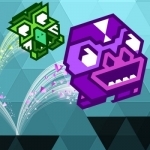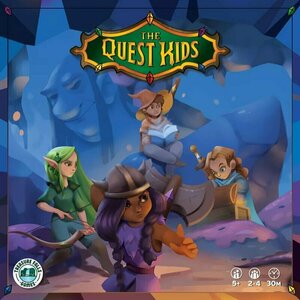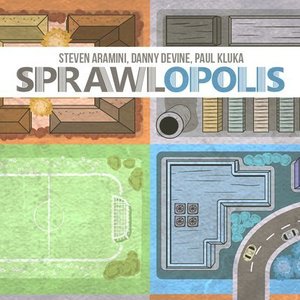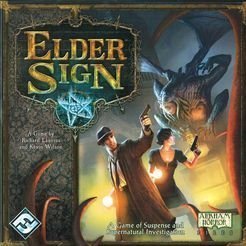
The Walking Dead: March To War
Games
App Watch
THE WALKING DEAD: MARCH TO WAR is an all-new intense multiplayer strategy game set in the world of...
games

If Hitler Comes: A Cautionary Tale
Christopher Serpell and Douglas Brown
Book
This novel was first published by Faber in August 1940 under the title, "The Loss of Eden". It was...
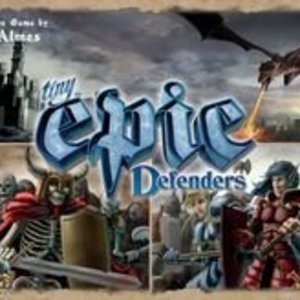
Tiny Epic Defenders
Tabletop Game
After the Great War (Tiny Epic Kingdoms), many of the factions, shattered and defeated, looked for...
Purple Phoenix Games (2266 KP) rated The Quest Kids in Tabletop Games
Mar 26, 2021
The Quest Kids is a dungeon crawler style board game for players as young as five years of age. Yes, FIVE! In it, players are acting as one of these Quest Kids, attempting to explore the cave of Tolk the Wise. The Quest Kids will find abilities to enhance their own, treasures to collect, and silly bad guys to scare away within, and the player with the most stars (VP) at the end will win the game!
DISCLAIMER: We were provided a copy of this game for the purposes of this review. This is a retail copy of the game, so what you see in these photos is exactly what would be received in your box. I do not intend to cover every single rule included in the rulebook, but will describe the overall game flow and major rule set so that our readers may get a sense of how the game plays. For more in depth rules, you may purchase a copy from the publisher online or from your FLGS. -T
To setup, place the large game board on the table and populate it with the green, gray, and red Dungeon Tiles according to the rules. Also prepare the card decks and place them appropriately in their spaces on the board. The Treasure Tokens are placed in the Treasure Bag. Each player will receive one Quest Kid Player Mat and matching figurine. In addition each player will receive three starting Health Cards, one Quest Card, and one appropriate starting Ability Card. The game may now begin from the entrance to the cave!
On a turn players will be able to have free movement around the board exploring tiles and resolving them in turns. Green tiles are always good for the players, Gray tiles may have some bad guys but are predominantly good, and Red tiles are littered with those silly bad guys that will need to be scared away. A player will travel to a board location and encounter a Dungeon Tile by flipping it over and collecting the resources shown or attempting to scare away the bad guys. Bad guys can be scared by discarding the printed Ability Cards on their tile. Once discarded, the player collects the tile to their Player Mat for stars at game end.
Sometimes players will encounter a bad guy they do not possess enough Ability Cards to scare away. In these scenarios the player may ask the other players for help. Nonactive players may then offer Ability Cards from their stash in order to help achieve the goal. For every Ability Card donated to the cause the donating Quest Kid will receive one Kind Kid Card. Kind Kid Cards are always great and can be resolved at ANY time during the game. Should a player encounter a bad guy they cannot scare away and other Quest Kids cannot help with Ability Cards, the active player will suffer a loss of one of their Health Cards (worth two stars).
Some tiles or Quest cards will instruct the player to draw one or more treasures from the Treasure Bag. Most treasures are good and provide stars, but some are blobs that eat stars. Each Treasure Token also has two values. The top value is for the normal amount of stars. However, the bottom value is worth more stars if the controlling player matches the Quest Kid printed on the token. Some treasure may be worth just one star unless the Quest Kid is a match, in which case it is then worth three stars, for example.
Turns continue in this fashion until all Dungeon Tiles have been resolved or a stalemate reached. At this point all players count up their stars they have collected from various sources and the player with the most stars is the winner!
Components. This is a kids’ game, can we all agree? THIS kids’ game, however, boasts some of the most interesting and wonderful components I have seen. The board is huge and depicts a magical cave. Super cool. The tiles are easy to read and understand, as with all the iconography. The Quest Kids themselves all have the same abilities (unless the expansion is added – and the review for that is coming soon), so that smaller children are not burdened with having to remember their special abilities. There are these plastic Tolk Gems that can be collected during the game and children absolutely flip for these things. And did you see those colorful and very big minis? I mean, come on! It’s a kids’ game! They LOVE minis! The game also comes with cardboard standees in case your children cannot handle the minis carefully enough.
Here is the deal. I absolutely adore these Quest Kids games. They are absolutely the perfect difficulty for young gamers who are ready to step up from the Candy Lands and Chutes & Ladders. Now, the box suggests 5+ but my 4-year-old did just fine with it, so take that with a grain of salt. Having had him already familiarize himself with The Quest Kids characters in The Quest Kids: Matching Adventure, this was an easier process getting this game to the table for us.
The game gives an exciting dungeon crawl experience for younger children, and it’s honestly something I never really knew I needed in my life until I now have it. It is so simple to teach and play and definitely encourages helping other players, if even just because you receive those Kind Kid cards in return. Anything to create that helpful player atmosphere to prepare them for heavier cooperative games is much appreciated.
Please do not misunderstand me. The Quest Kids is targeting younger players, but I do believe that any aged gamer could appreciate and have a good time with this. It certainly will not fill the void of other dungeon crawlers, but if you need a fix and would like to spend 20-45 minutes playing something to scratch that itch, then pull out your copy of The Quest Kids. It is super-light, colorful, and is a perfect stepping stone to bigger cooperative games. Purple Phoenix Games (with special guest Finley) gives this one a Kind 11/12. Please visit the publisher’s website to pick up your copy, and have a great time introducing your children (or partners, in-laws, grannies, pets, whomever) to cooperative dungeon crawls that will have you leaving the table in a much better mood than when you sat down.
Purple Phoenix Games (2266 KP) rated Sprawlopolis in Tabletop Games
Jun 12, 2019
If you had the chance to design a city, how would you do it? Would you have a park on every block for some nice greenery, or do you think a large commercial district will bring in more people? What about housing – would people live right in the heart of the city, or would they live more on the outskirts? The day has finally come where those decisions are up to you! Well, mostly. You’ve been hired to help design the ultimate city! The city officials have given you some specific requirements, but beyond that, the plans are up to you! Can you meet their needs while also maximizing your space? It’s time to put your skills to the test and build the best city ever!
Sprawlopolis is a cooperative card placement game of only 18 cards. Given 3 random scoring conditions, you must draw and play cards into the city to fulfill those requirements. Meet or exceed their score, and you win the game! Fail to do so, and you have not succeeded in building the city up to specifications. Be careful how you decide to place your cards, however, because depending on the scoring conditions in play, certain placements could result in negative points at the end of the game. Working together, you and your team must decide which cards to play at what time to ensure that the requirements are all met. Solo play is identical to cooperative play, except that you just always have a hand of 3 cards from which to play. The score to beat each game is dependent on the scoring conditions, so this game isn’t just another beat-your-own-high-score game – you actually have a specific number in mind.
For a game with only 18 cards, there is a lot of variability in Sprawlopolis. I have yet to play 2 identical games. The layout of each card is unique, as are all of the scoring conditions, so the possibilities are endless… almost! I also enjoy playing this game solo because it requires a decent amount of strategy. Three things factor into your final score (the scoring conditions, block groupings, and roads) and it is impossible to succeed by focusing on only one of them. Your strategy is always changing based on the cards in your hand, and you really have to think about how to best utilize each card for maximum end-game points. Depending on when and where you play a card, it could change the entire city so you have to be thinking about the big picture, literally! And a neat thing about Sprawlopolis is that you can overlap cards. So maybe a card you played earlier is not really ideal anymore, given your current hand, so you can just cover up either a portion of it or the entire card!
The hardest thing about Sprawlopolis for me is that certain combinations of scoring conditions can be difficult to complete. One may give you points for a certain type of city block, but then another may take away as many, or more, points for that same type of city block. Or one gives you points for certain roads, but all roads result in negative points during end-game scoring. Since the scoring conditions are chosen randomly, there’s not really a way to negate this unless you just re-draw those cards. You usually can’t just look at a scoring condition combination and know if it will be difficult or not either – you just have to try it. I’m not saying they’re impossible necessarily, just harder to successfully complete.
Overall, I think Sprawlopolis is a neat game. It’s fast and easy to learn, yet strategic enough to keep you coming back for more games. I like to use it as a nice light filler game between some bigger games, or I just like to play it if I’ve got a quick 15 minutes to spare! Sprawlopolis is a fun game to play with a group, and it’s also a fun game to play solo. In my arsenal of solo games, it’s definitely one on standby.
https://purplephoenixgames.wordpress.com/2019/02/11/solo-chronicles-sprawlopolis/
So, what's it about? Well, a pair of London coppers (cockney geezer and troubled waif) stumble upon a USB stick containing the government's advance planning for the end of the world, which is due in about five years. Quite what form this planning takes is a little unclear, as it neglects to mention just what form the apocalypse is going to take (which if nothing else allows the show a nice big revelation at the end of the season). Geezer and Waif must try to get the truth out there while fending off government agents who want them dead!
Except, it's not really about that: news of the impending catastrophe, whatever it is, lures various nutters out of the woodwork to start committing grisly murders, and - wouldn't you know it - whenever Geezer and Waif get a spare moment from being hunted by the government, they have to go around catching them By Any Means Necessary! (At one point Geezer contemplates waterboarding an innocent man who's not being cooperative enough.)
Except, it's not just about that, either, for Geezer and Waif have the most implausibly complicated back-stories known to man, involving an extramarital fling, a secure unit, an internal affairs investigation, the murder of Geezer's old partner, a secret deal, and Waif's homicidal grown-up son (who seems to be nearly as old as she is).
All of this stuff bangs together in the most grisly and unlikely fashion, with a general tone of overwrought existential misery (every one of the duo's cases either features a moment where they literally start beating each other up with collapsible truncheons, or one where they sit down together and wail 'What's the point of any of this? We're all going to be dead in five years anyway!').
The sheer ridiculousness of Hard Sun makes it quite watchable in a stick-it-on-in-the-background-while-you're-doing-something else kind of way; every time you find yourself saying 'This can't possibly get any sillier' the show comes right back and proves you wrong. The makers of the show are clearly hoping for a full five year run, counting down to the actual apocalypse itself, although clearly the format is in for a big retool somewhere along the line. Fingers crossed this finds the devoted global audience such a potential cult camp classic deserves.
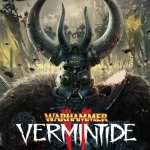
Warhammer: Vermintide 2
Video Game Watch
Vermintide is back – darker, bloodier and more intense than ever! Warhammer: Vermintide 2 is...
action warhammer

Robert Capa: A Graphic Biography
Book
'If your pictures aren't good enough, you aren't close enough.' - Robert Capa. 'Robert Capa: A...
Matthew Krueger (10051 KP) rated Elder Sign in Tabletop Games
Jul 17, 2020 (Updated Jul 18, 2020)
Elder Sign- is a cooperative card and dice game, based on the Cthulhu Mythos of horror writer H.P. Lovecraft and Chaosium's Call of Cthulhu roleplaying game. It is published by Fantasy Flight Games, which also produces the Cthulhu Mythos games Arkham Horror, Call of Cthulhu: The Card Game, Mansions of Madness, and Eldritch Horror.
Gameplay:
Players randomly select a monster (known as an Ancient One) to oppose. The Ancient One requires a certain number of elder sign tokens to "seal" or imprison it. Conversely, the Ancient One can be "awakened" or released by a number of doom tokens.
There are also many other less powerful monsters that can appear during the game.
Each player chooses an investigator to play as (usually randomly), each investigator having unique abilities.
Players take turns exploring a randomly generated room (there are Adventure cards and Other World cards). If a player succeeds at completing all of the tasks in the room they are exploring, they obtain a reward. Conversely, if they fail, they receive a penalty. If the player's investigator is devoured (either by losing all of their stamina and/or sanity), they lose what they originally had, a doom token is added to the doom track, and the player returns to play as a different investigator.
Rooms are explored until either the Ancient One is "sealed" or "awakened". If the Ancient One is sealed, the players immediately win. If the Ancient One awakens, the players must face it in battle. This battle is designed to be extremely difficult with a low chance of success, so players must try to prevent the Ancient One from awakening at all costs.
Its a excellent gothic horror game, it has fantasy, dice, cards and adventure and alot of replayablity. Buy it if you havent already. Cause its excellent.
